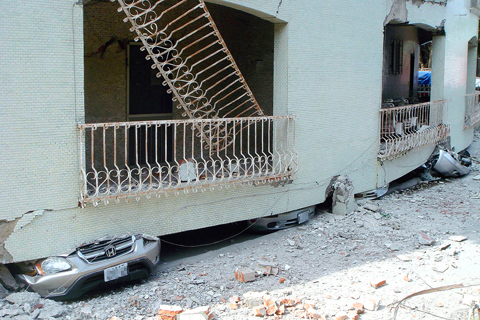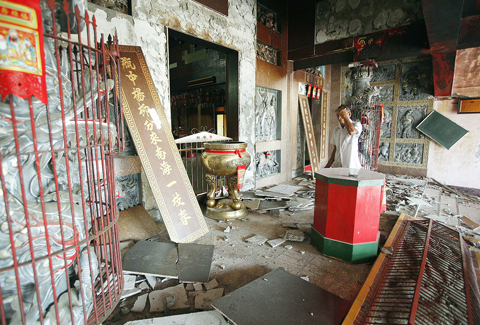A 6.4-magnitude earthquake jolted southern Taiwan at 8:18am yesterday, damaging houses, cutting power supplies and disrupting the nation’s transportation systems.
No fatalities have been reported, although 64 people were injured, mainly by falling objects.
Central Weather Bureau (CWB) statistics showed that the epicenter of the quake was 17km southeast of the bureau’s observation center in Jiasian Township (甲仙), Kaohsiung County, at a depth of 5km.

PHOTO: CNA
The temblor was felt nationwide, with the highest intensity — 6 on the Richter Scale — detected in Nansi (楠西), Tainan County, and Dapu (大埔), Chiayi County.
The intensity of the quake was 5 in Jiasian and 4 in Taitung, Changhua, Kaohsiung and Yunlin counties. The force of the earthquake was the equivalent of about two atomic bombs, the bureau said.
Dozens of aftershocks were felt later, including a 5.7-magnitude tremor about the same location at 4:16pm, at a depth of 16.6km. Historical records showed that the 6.4 temblor was the strongest to hit the region since 1902.

PHOTO: NICKY LOH, REUTERS
The epicenter was just a few kilometers from Siaolin Village (小林), which was wiped out and where about 500 people were killed by landslides following Typhoon Morakot in August.
The earthquake triggered a minor landslide in Guanshan Village (關山) next to Siaolin. No injuries were reported as all residents in the area were relocated following Morakot.
In nearby Shanlin Township (杉林), however, a traditional brick house collapsed after the quake, with 85-year-old owner Chang Yu-mei (張有妹) narrowly escaping injury.

PHOTO: CNA
“I was sitting in the living room watching TV alone when the earthquake struck. The earth suddenly began shaking — it was very scary,” Chang told the Chinese-language United Evening News.
Chang said she ran out of the house after hearing a weird sound coming from the roof.
“As soon as I got out, the roof collapsed,” she was quoted as saying.
A 4m crack appeared on a wall of the recently built Liouguei Township (六龜) Office and several lamps fell from the ceiling.
Damage to buildings was reported in Tainan, Pingtung and Chiayi counties.
The Gaomei Bridge (高美大橋) in Gaoshu (高樹) cracked and was closed to traffic. In Yujing Township (玉井), Tainan County, pillars were so severely damaged at Yujing Junior High School that school officials declared some classrooms off-limits. Officials said some classes could be relocated to a school nearby.
A 15m crack appeared on top of the Hutoupi Reservoir (虎頭埤水庫) in Tainan County. At press time, specialists were still assessing the damage.
In Kaohsiung City, the MRT system suspended service from 8:19am to 10:47am to perform safety checks.
Those who entered or exited stations between 8:19am and 10:47am will have seven days to apply for a refund at service desks, the operator said.
Six high speed rail trains were stopped and about 2,400 passengers had to evacuate the trains. They walked along the elevated tracks and boarded buses provided by Taiwan High Speed Rail Corp (THSRC).
THSRC canceled services between Taichung and Zuoying (左營) yesterday to inspect the tracks for damage, with the Taiwan Railway Administration (TRA) increasing the number of trains traveling to Zuoying to make up for the suspension of the high speed rail service.
Democratic Progressive Party Legislator Huang Wei-cher (黃偉哲) was aboard train No. 110 from Zouying to Taipei and was trapped inside for more than two hours after it stopped in Sinshih Township (新市), Tainan County.
“There was no air-conditioning in the train, it was very hot inside and we were only allowed to leave the train after two-and-a-half hours,” Huang said.
“There were many elderly or physically impaired passengers on board, but we were asked to walk along the track and when we finally reached the location where we boarded a shuttle bus, we had to wait for a long time before the bus arrived,” he said.
“Had this been an exercise, Taiwan High Speed Rail would have failed,” Huang said.
The TRA also found minor damage on two railway bridges. Trains operating on these two sections had to slow down to 40kph.
The Civil Aeronautics Administration requested that the three domestic airlines increase their flights to Chiayi, Tainan and Kaohsiung yesterday and today.
THSRC said that operations were scheduled to resume today.
The CWB initially said the earthquake was caused by the dislocation of the fault in Chaojhou (潮州斷層), one of the main faults in the Kaohsiung area. Later it said that based on the data it had gathered, it could not tell with certainty that the fault was the cause.
Aside from Chaojhou, Kaohsiung also has the Liouguei (六龜) and Cishan (旗山) faults. The epicenter of the earthquake was only 8km from the Chaojhou fault and about 20km from the other two faults.
ADDITIONAL REPORTING BY VINCENT Y. CHAO
Also See: Agencies on alert after quake
Also See: Disruption as quake rocks parks

The US government has signed defense cooperation agreements with Japan and the Philippines to boost the deterrence capabilities of countries in the first island chain, a report by the National Security Bureau (NSB) showed. The main countries on the first island chain include the two nations and Taiwan. The bureau is to present the report at a meeting of the legislature’s Foreign Affairs and National Defense Committee tomorrow. The US military has deployed Typhon missile systems to Japan’s Yamaguchi Prefecture and Zambales province in the Philippines during their joint military exercises. It has also installed NMESIS anti-ship systems in Japan’s Okinawa

‘WIN-WIN’: The Philippines, and central and eastern European countries are important potential drone cooperation partners, Minister of Foreign Affairs Lin Chia-lung said Minister of Foreign Affairs Lin Chia-lung (林佳龍) in an interview published yesterday confirmed that there are joint ventures between Taiwan and Poland in the drone industry. Lin made the remark in an exclusive interview with the Chinese-language Liberty Times (the Taipei Times’ sister paper). The government-backed Taiwan Excellence Drone International Business Opportunities Alliance and the Polish Chamber of Unmanned Systems on Wednesday last week signed a memorandum of understanding in Poland to develop a “non-China” supply chain for drones and work together on key technologies. Asked if Taiwan prioritized Poland among central and eastern European countries in drone collaboration, Lin

NO CONFIDENCE MOTION? The premier said that being toppled by the legislature for defending the Constitution would be a democratic badge of honor for him Premier Cho Jung-tai (卓榮泰) yesterday announced that the Cabinet would not countersign the amendments to the local revenue-sharing law passed by the Legislative Yuan last month. Cho said the decision not to countersign the amendments to the Act Governing the Allocation of Government Revenues and Expenditures (財政收支劃分法) was made in accordance with the Constitution. “The decision aims to safeguard our Constitution,” he said. The Constitution stipulates the president shall, in accordance with law, promulgate laws and issue mandates with the countersignature of the head of the Executive Yuan, or with the countersignatures of both the head of the Executive Yuan and ministers or

CABINET APPROVAL: People seeking assisted reproduction must be assessed to determine whether they would be adequate parents, the planned changes say Proposed amendments to the Assisted Reproduction Act (人工生殖法) advanced yesterday by the Executive Yuan would grant married lesbian couples and single women access to legal assisted reproductive services. The proposed revisions are “based on the fundamental principle of respecting women’s reproductive autonomy,” Cabinet spokesperson Michelle Lee (李慧芝) quoted Vice Premier Cheng Li-chiun (鄭麗君), who presided over a Cabinet meeting earlier yesterday, as saying at the briefing. The draft amendment would be submitted to the legislature for review. The Ministry of Health and Welfare, which proposed the amendments, said that experts on children’s rights, gender equality, law and medicine attended cross-disciplinary meetings, adding that